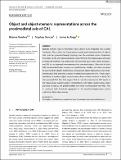Files in this item
Object and object-memory representations across the proximodistal axis of CA1
Item metadata
| dc.contributor.author | Vandrey, Brianna | |
| dc.contributor.author | Duncan, Stephen | |
| dc.contributor.author | Ainge, James Alexander | |
| dc.date.accessioned | 2021-05-06T15:30:29Z | |
| dc.date.available | 2021-05-06T15:30:29Z | |
| dc.date.issued | 2021-07-20 | |
| dc.identifier | 273716945 | |
| dc.identifier | 544654ba-2547-40c0-9d85-4aca421ba1de | |
| dc.identifier | 000646466100001 | |
| dc.identifier | 85105077687 | |
| dc.identifier.citation | Vandrey , B , Duncan , S & Ainge , J A 2021 , ' Object and object-memory representations across the proximodistal axis of CA1 ' , Hippocampus , vol. 31 , no. 8 , pp. 881-896 . https://doi.org/10.1002/hipo.23331 | en |
| dc.identifier.issn | 1050-9631 | |
| dc.identifier.other | ORCID: /0000-0002-0007-1533/work/93515206 | |
| dc.identifier.uri | https://hdl.handle.net/10023/23123 | |
| dc.description | Funding: Royal Society of Edinburgh (Grant Number(s): Henry Dryerre scholarship). | en |
| dc.description.abstract | Episodic memory requires information about objects to be integrated into a spatial framework. Place cells in the hippocampus encode spatial representations of objects that could be generated through signaling from the entorhinal cortex. Projections from lateral (LEC) and medial entorhinal cortex (MEC) to the hippocampus terminate in distal and proximal CA1, respectively. We recorded place cells in distal and proximal CA1 as rats explored an environment that contained objects. Place cells in distal CA1 demonstrated higher measures of spatial tuning, stability, and closer proximity of place fields to objects. Furthermore, remapping to object displacement was modulated by place field proximity to objects in distal, but not proximal CA1. Finally, representations of previous object locations were closer to those locations in distal CA1 than proximal CA1. Our data suggest that in cue‐rich environments, LEC inputs to the hippocampus support spatial representations with higher spatial tuning, closer proximity to objects, and greater stability than those receiving inputs from MEC. This is consistent with functional segregation in the entorhinal–hippocampal circuits underlying object‐place memory. | |
| dc.format.extent | 16 | |
| dc.format.extent | 3374142 | |
| dc.language.iso | eng | |
| dc.relation.ispartof | Hippocampus | en |
| dc.subject | CA1 region | en |
| dc.subject | Entorhinal cortex | en |
| dc.subject | Episodic memory | en |
| dc.subject | Hippocampus | en |
| dc.subject | Place cell | en |
| dc.subject | Spatial memory | en |
| dc.subject | RC0321 Neuroscience. Biological psychiatry. Neuropsychiatry | en |
| dc.subject | NDAS | en |
| dc.subject.lcc | RC0321 | en |
| dc.title | Object and object-memory representations across the proximodistal axis of CA1 | en |
| dc.type | Journal article | en |
| dc.contributor.institution | University of St Andrews. School of Psychology and Neuroscience | en |
| dc.identifier.doi | https://doi.org/10.1002/hipo.23331 | |
| dc.description.status | Peer reviewed | en |
| dc.identifier.url | https://www.biorxiv.org/content/10.1101/2020.06.19.160911v1 | en |
This item appears in the following Collection(s)
Items in the St Andrews Research Repository are protected by copyright, with all rights reserved, unless otherwise indicated.

